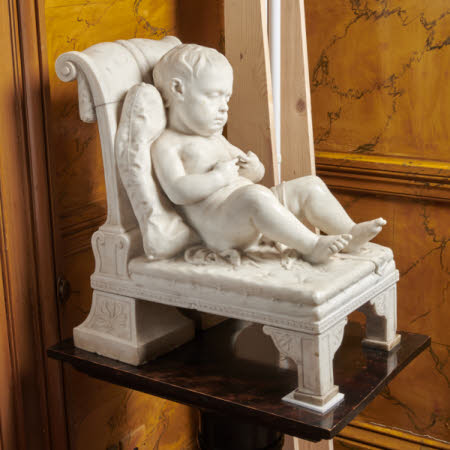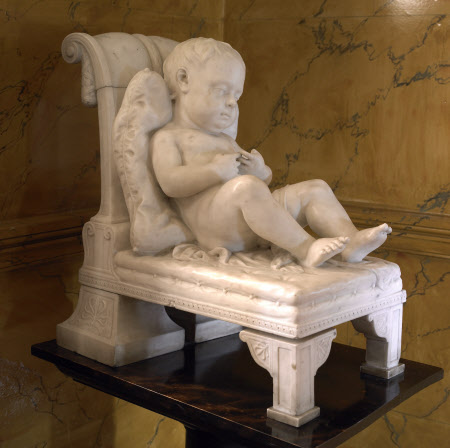Child asleep upon a Greek chair
Thomas Kirk RHA (Cork 1781 - Dublin 1845)
Category
Art / Sculpture
Date
1826
Materials
Stone
Measurements
521 x 330 mm; 470 mm (L)
Place of origin
Dublin
Order this imageCollection
The Argory, County Armagh
NT 565244
Summary
Sculpture, marble; Child asleep upon a Greek chair; Thomas Kirk (1781-1845); 1826. A marble sculpture by Thomas Kirk depicting a young child asleep upon a chair in neo-classical style. Commissioned by Walter McGeough Bond (1790-1866) and exhibited at the Royal Hibernian Academy in Dublin in 1826. A companion to Kirk’s sculpture of a Boy catching a butterfly, also at the Argory (NT 565245).
Full description
A marble sculpture depicting a young boy who lies asleep upon a chair, his fingers intertwined. He is naked except for a drapery, on most of which he lies, but part of which passes over his left thigh. The boy is propped against a fat cushion. The chair is in the Grecian style, and has square feet at the front and a thick tapering foot at the back, both decorated with anthemion ornament. The chair back curves gently backwards and is scrolled at the top, with pendentive swags. Signed and dated on the back, towards the bottom. The left thumb broken off, and a crack in the marble of the seat, behind the boy’s head. The Cork-born sculptor Thomas Kirk (1781-1845) had the most important sculpture practice in Ireland during the first half of the nineteenth century (for Kirk, see Murphy 2010, pp. 52-57; Murphy 2014, pp. 205-07). Unlike other successful Irish-born sculptors such as John Henry Foley, Kirk opted not to move to London to further his career, but remained in Dublin, where he made a number of patriotic commissions for Anglo-Irish and Protestant patrons, and was particularly noted as a portrait sculptor. At the first exhibition of the Royal Hibernian Academy in 1826, Kirk exhibited, as well as the Child asleep upon a Greek chair, a number of other works, including what was described in one report as the ‘fine collossal’ statue of the Unionist politician Thomas Spring Rice (1790-1866), shown alongside a cast of the Barberini Faun, donated to the RHA by Sir Thomas Lawrence, and ‘collossal Busts of Canova and Thorwalden [sic] , sent from Rome’ (Bolster’s Quarterly Magazine, Vol. I (1826), p. 288). The sculpture was commissioned from Thomas Kirk by Walter McGeough Bond (1790-1866) and was exhibited at the Royal Hibernian Academy in Dublin in 1826, as ‘A Child asleep upon a Greek Chair, executed for W. McG. Bond, Esq.’ The most remarkable element of the sculpture is indeed the neo-classical chair, in advanced Greek revival style. The sculpture is a companion, if not a strict pair, to Kirk’s ‘Boy catching a butterfly’, also dated 1826 but only exhibited at the RHA in 1827 (NT 565245), and the model in both sculptures may well be the same small boy. They are charming compositions in the neo-classical style, which just manage to avoid over-sentimentality. Jeremy Warren September 2022
Provenance
Commissioned from the artist by Walter McGeough Bond (1790-1866); exhibited at the Royal Hibernian Academy in Dublin in 1826; by descent; given to the National Trust by Walter Albert Nevill MacGeough Bond (1908-1986) in 1979.
Marks and inscriptions
Back of chair, towards bottom:: Thos. Kirk Inven(i)t et sculpt. 1826
Makers and roles
Thomas Kirk RHA (Cork 1781 - Dublin 1845), sculptor
References
Strickland 1913: W. G. Strickland, Dictionary of Irish Artists, 2 vols.1913, I, p. 592. Stewart 1985-87: Ann M. Stewart, Royal Hibernian Academy of Arts: Index of exhibitors and their works 1826-1979, 3 vols., Dublin 1985-1987, II, p. 165, 1826, no. 387. Roscoe 2009: I. Roscoe, E. Hardy and M. G. Sullivan, A Biographical Dictionary of Sculptors in Britain 1660-1851, New Haven and Yale 2009, p. 708, no. 38. Murphy 2010: Paula Murphy, Nineteenth-Century Irish Sculpture. Native Genius Reaffirmed, New Haven/London 2010 Murphy 2014: Paula Murphy, ed., Art and Architecture of Ireland. III. Sculpture 1600-2000, Dublin/New Haven/London 2014


